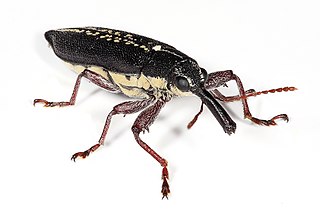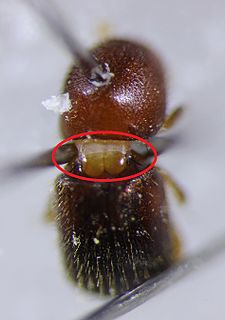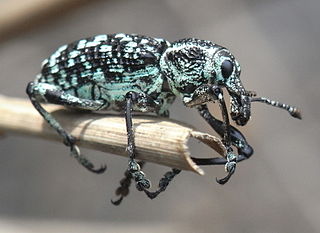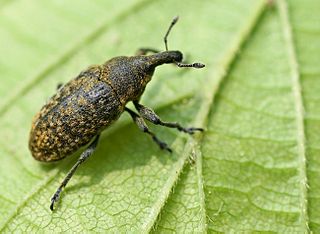
The Curculionidae are the family of the "true" weevils. They are one of the largest animal families, with 6,800 genera and 83,000 species described worldwide.

Weevils are a type of beetle belonging to the superfamily Curculionoidea. They are usually small, less than 6 mm in length, and herbivorous. About 97,000 species of weevils are known. They belong to several families, with most of them in the family Curculionidae. Some other beetles, although not closely related, bear the name "weevil", such as the biscuit weevil, which belongs to the family Ptinidae.

Woodworm is the wood-eating larvae of many species of beetle. It is also a generic description given to the infestation of a wooden item by these larvae.

Belidae is a family of weevils, called belids or primitive weevils because they have straight antennae, unlike the "true weevils" or Curculionidae which have elbowed antennae. They are sometimes known as "cycad weevils", but this properly refers to a few species from the genera Parallocorynus and Rhopalotria.

The term mycangium is used in biology for special structures on the body of an animal that are adapted for the transport of symbiotic fungi. This is seen in many xylophagous insects, which apparently derive much of their nutrition from the digestion of various fungi that are growing amidst the wood fibers. In some cases, as in ambrosia beetles, the fungi are the sole food, and the excavations in the wood are simply to make a suitable microenvironment for the fungus to grow. In other cases, wood tissue is the main food, and fungi weaken the defense response from the host plant.

Hylobius is a genus of true weevils. Several Hylobius species are major pests of coniferous trees.

Chrysolopus spectabilis is a species of weevil found in south-eastern Australia. It was discovered during James Cook's first voyage, and became the first insect to be described from Australia. The weevil measures up to 25 mm (1.0 in) long and includes distinctive metallic green and black scales. It is found only on 28 species of the plant genus Acacia.

Curculio is a genus of weevils belonging the family Curculionidae and subfamily Curculioninae. Members of the genus are commonly referred to as acorn weevils or nut weevils as they infest the seeds of trees such as oaks and hickories. The adult female weevil bores a tiny hole in the immature nut to lay her eggs, which then hatch into legless grubs. In the fall, the grubs bore holes through the shells from the inside to emerge into the soil where they may live for a year or two before maturing into adults.

The palm weevil Rhynchophorus ferrugineus is one of two species of snout beetle known as the red palm weevil, Asian palm weevil or sago palm weevil. The adult beetles are relatively large, ranging between two and four centimeters long, and are usually a rusty red colour—but many colour variants exist and have often been classified as different species. Weevil larvae can excavate holes in the trunk of a palm trees up to a metre long, thereby weakening and eventually killing the host plant. As a result, the weevil is considered a major pest in palm plantations, including the coconut palm, date palm and oil palm.

Pentarthrum is a genus of beetle in family Curculionidae. It contains about 70 species of mainly tropical distribution.

Cyphocleonus achates is a species of true weevil known as the knapweed root weevil. It is native to southern Europe and the Mediterranean and is used as an agent of biological pest control against noxious knapweeds, especially spotted knapweed. It has recently been spotted in India.

Belinae are a Gondwanan subfamily of beetles which belong to the belids, primitive weevils of the family Belidae. Like in other belids, their antennae are straight, not elbowed as in the true weevils (Curculionidae). The Belinae make up the bulk of the diversity of living belid genera. They are found in the Australia-New Guinea-New Zealand and South America.

Larinus planus is an insect of the Curculionidae family. They are oval shaped, dark brown or black, and about 5-10 millimeters long. While native to Europe, it is also common in North America. It feeds on floral buds, primarily of thistles, with the larvae stage being the most destructive to them. In North America, it has been used as a biocontrol agent. It is also known as Larinus carlinae.

Phyllobius glaucus is a species of weevil found across Europe, especially in carrs. It is a pest of a variety of fruit trees, but has little economic effect. It was first described by Giovanni Antonio Scopoli in 1763.

Hylobius transversovittatus is a species of weevil in the family Curculionidae. It is native to the Old World where both adults and larvae feed on purple loosestrife. This plant is regarded as an invasive species in North America and the weevil has been introduced into both the United States and Canada in an effort to control the plant.

Hylastes ater is a species of beetle in the family Curculionidae, the true weevils. It is a bark beetle, a member of the subfamily Scolytinae. Its common name is the black pine bark beetle. It is native to Europe and parts of Asia, including China and Korea. It is known as an introduced species in many other regions, including Australia, New Zealand, the Americas, and South Africa. It is a pest of pines and other trees, and it is widespread in areas where pine trees are cultivated. The species "is an important threat to the biosecurity of all forested countries."

Cossoninae is a true weevil subfamily in the family Curculionidae.

Lyperobius huttoni is a New Zealand weevil found in alpine areas of the South Island and at sea level around the Wellington coast. It feeds only on speargrass (Aciphylla). Weevils from the endangered Wellington population have been translocated to predator-free Mana Island.

Lyperobius hudsoni is a flightless weevil found in alpine areas of Central Otago and Otago Lakes in the South Island of New Zealand.
Diocalandra frumenti, commonly known as the palm weevil borer, the lesser coconut weevil, or four-spotted coconut weevil, is a species of weevil in the family Curculionidae. It occurs in Africa, Southern Asia and Northern Australia, and is a pest of coconut and other palm trees.



















